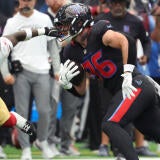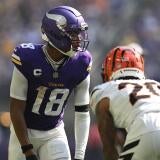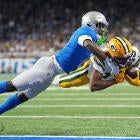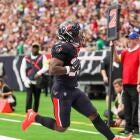Fantasy Football: Zac Taylor will bring promise to Bengals passing game
Zac Taylor hasn't been around the NFL game very long and has barely more than one season's experience calling plays, but he should still help restart the Bengals passing game in 2019.
When former quarterbacks become play callers, it typically favors the passing game. That should be the case for Andy Dalton and the Bengals with Zac Taylor in charge in Cincinnati.
A hot name in the coaching search threads for a couple of years now, Taylor played college ball at Nebraska right when they went to the West Coast offense under Bill Callahan. After getting cut before Buccaneers training camp in 2006, Taylor was a fourth-string quarterback with the Winnipeg Blue Bombers of the CFL in 2007.
Most fourth-string passers don't make it in Canada, or anywhere, so Taylor quickly got into coaching in 2008 as an assistant with Texas A&M under former NFL coach Mike Sherman ... while also dating his daughter. Taylor eventually married Sherman's daughter while also following his father-in-law to work with the Dolphins. He would stay with the team even after Sherman got fired, eventually becoming interim offensive coordinator, replacing Bill Lazor for five games in 2015.
After getting dumped by the Dolphins, Taylor landed on his feet at the University of Cincinnati as Tommy Tuberville's offensive coordinator in 2016. His one season there was a disaster -- the Bearcats went 4-8 -- but it didn't hurt Taylor as he became an assistant with Sean McVay's Rams in 2017. He then got promoted to quarterbacks coach in 2018, which apparently was enough to get him the head coaching job with the Bengals. Fun fact: Taylor is again replacing Lazor as play caller.
The common thread? Taylor stayed grounded in the West Coast offense -- nearly every coach he worked with/married into was well-versed in it. The playbook should be robust and at the tip of Taylor's tongue. That's a positive for Dalton, who was considered a West Coast quarterback when he came out of TCU eight years ago and has been in that very system his entire career.
Many of his peers and former players believe he's clever, relatable and is kind of a quarterback whisperer, which will come in handy if (when?) the Bengals move on from Dalton. We'll find out just how creative he is, but his lack of experience is a little worrisome. Fortunately for him, the Bengals have been a little more patient with their coaches than other teams around the league, so Taylor should have time to morph into, hopefully, a good playcaller.
Here's a look at Taylor's playcalling tendencies from his five games with the Dolphins in 2015 and his season with the Bearcats in 2016.
Pass-run ratio
It's actually a little surprising that Taylor didn't throw more during a bust season in college and playing out the string with the Fins. For the record, Taylor was more aggressive with Miami, registering a 59-44 pass-run ratio. Ryan Tannehill was the better quarterback to lean on compared to the motley crew he had at Cincinnati. Besides, it's never a shock to see a former quarterback lean on putting the ball in the air.
Expect the Bengals to at worst have a pass ratio of 56-44. That would seem to favor Dalton, though not quite enough to put him into the late-round quarterback sleeper conversation.
RB rushes per game
This should mean real good things for Mixon. The Bengals will frequently roll with zone-blocking principles to allow Mixon the timing and patience he thrives on to succeed -- changing that would hurt his outlook.
Taylor's backs with the Dolphins averaged 22.2 rushes per game while the Bearcats' scatbacks got 24.5 per game. Neither stat screams "Taylor's gonna run it a ton," but both are healthy averages, especially for an ex-quarterback playcaller. At this time, no one's drafting Mixon expecting him to significantly split carries, but if the Bengals add some firepower to their backfield, it could threaten Mixon's share. Taylor has used multiple backs before -- he went back and forth from giving Lamar Miller a lot of the workload to splitting it close to 60-40 with Jay Ajayi and Damien Williams, and he had Tion Green and Mike Boone in a 60-40 split during his college stint.
The hope is that the Bengals fortify their offensive line, not their backfield.
Reception Distribution
This data dovetails nicely with Dalton's best targets -- Mixon, Green, Boyd and even speedster John Ross. All four have potential in Taylor's system.
The running back receptions were particularly consistent -- they caught 20 percent of the targets in Miami and 20.1 percent with the Bearcats. So if Dalton is in line for, say, 300 completions, we could see 60 receptions among the Bengals running backs with most of them theoretically landing in Mixon's paws. Tack this on to the expected frequency of Mixon's carries and the outlook is great. He will be one of the first 10 backs taken in Fantasy drafts and a top-20 Fantasy pick.
Had Taylor's tight ends actually been quality playmakers, he probably would have found ways to get them involved. His guys in Miami weren't effective (Jordan Cameron, Dion Sims) and his trio of tight ends at Cincinnati totaled 10 receptions. What's telling is how the Rams haven't used their tight end duo of Tyler Higbee and Gerald Everett the past two seasons. McVay has put one of them on the field a bunch, but rarely both, and neither one as a regular target. With the receivers on the Bengals' roster we could see a lot of three-wide sets that under-utilize their tight ends. Whether the Bengals bring back Tyler Eifert or if they stick with C.J. Uzomah, don't count on a tight end being a big playmaker.
That's because the best playmakers are out wide and in the slot. Taylor will absolutely find ways to get Green open, utilizing route combinations with Ross and Boyd that should force defenses to abandon double-covering anyone. Green has already expressed delight in Taylor's system, suggesting it's a lot like Jay Gruden's version of the West Coast offense. He's fine so long as he's healthy.
Meanwhile, Jarvis Landry had some outstanding games under Taylor as did Nate Cole, his primary slot receiver at Cincinnati. Last year, Boyd lined up in the slot 71.7 percent of his snaps and ran 73.5 percent of his routes from there. Not only should we expect Boyd to reprise that role but be featured in it.
Odds are long that Ross will live up to his first-round selection, but his new coach is sure to take advantage of his speed. Expect him to cement himself as a deep-ball threat, even if he's been more of a lucky short-yardage guy on five of his seven career touchdowns.
Fantasy owners should feel good about choosing Green and Boyd because they're locks to be high-volume targets in this offense. Green might wind up as the steal of the draft with a third-round pick while Boyd will get taken closer to 50th overall.

















